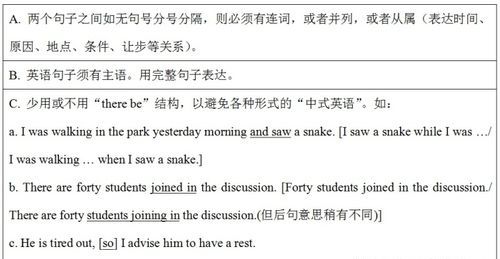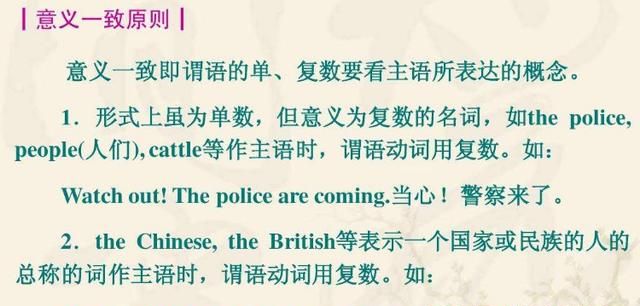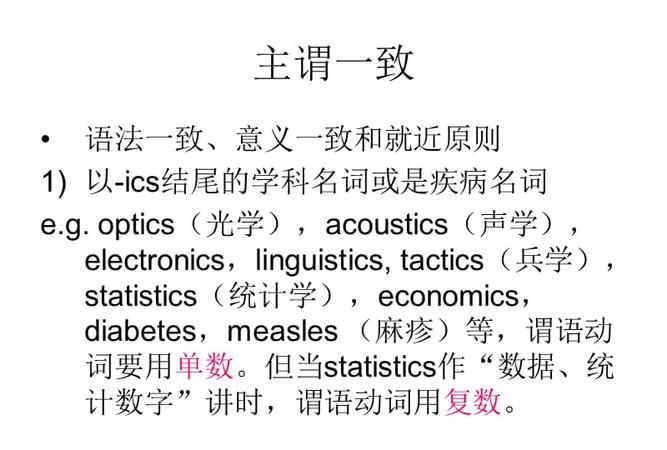本文目录
主谓一致quantity of
一样

主谓一致视频讲解
主 谓 一 致 的 三 个 原 则
A 语法一致
语法一致是指主语和谓语在单复数形式上的一致关系,主语为单数形式,谓语动词用单数形式;反之,谓语动词用复数形式.
My child has no intention of spending a vacation with me.
My children have no intention of spending a vacation with me.
B 意义一致
意义一致是说谓语动词的单,复数要取决于主语所表达的概念,而不取决于表面上的语法标记.
1.主语形式虽为单数,但意义为复数,谓语动词用复数.
The majority of primary school teachers are women.
2.主语形式为复数,而意义上却是单数,谓语动词用单数.
No news is good news.
Billiards is becoming more and more popular in some cities.
C 就近原则
就近原则是指当主语由两个或两个以上名词或代词组成时,谓语动词的数要与它紧邻的名词或代词的数一致.
There is a square table and some chairs in the center of the dining-room.
Either your students or William knows this.
提 示
一般说来,究竟何时采用何种原则,应视英语习惯用法而定.但在实际使用中,如果对上述三种原则捉摸不定时,遵循语法一致的原则是一种比较稳妥的方法.
并列主语的主谓一致
A 由and连接的并列主语
1.用and (或both...and) 连接并列主语时,谓语动词通常用复数.
A hammer and a saw are useful tools.
★当and连接的两个名词是指组合到一起的一件完整的或成套的东西,或表示同一个人或一种概念时,谓语动词要用单数形式.
The writer and teacher is speaking at the meeting.
必 背
英语中并列结构表示整体概念的有:
iron and steel__ 钢铁
a needle and thread 针线
aim and end__ 目的
going to bed early and getting up early 早睡早起
a watch and chain__ 一块带链的表
a cart and horse 一辆马车
a coat and tie__ 配有领带的上衣
bread and butter__ 黄油面包
law and order__ 治安
a knife and fork__ 刀叉
2.一个名词为几个并列形容词所修饰时,这时主语和谓语动词的一致关系一般遵循语法一致的原则.
Clever and slow students are treated alike.
A black and white kitten was found in the garden yesterday.
比 较
A black and a white dogs are playing in the yard.
A black and white dog is playing in the yard.
3.在each...and each..., every...and every..., no...and no...等结构之后,谓语动词用单数形式.
Each boy and each girl has an apple.
Every hour and every minute is precious.
No bird and no beast is seen on the lonely island.
4.带有并列动词的what从句作主语时,要根据意义一致的原则决定动词的数.
What he says and does do not agree.
What he says and does does not concern me.
5.在某些成语中,一些并列主语用and相连时,其后谓语用单数.
All work and no play makes Jack a dull boy.
Early to bed and early to rise makes a man healthy, wealthy and wise.
B 某些词组采取就近原则
以or, either...or, neither...nor, not...but, not only...but also等连接的名词(代词)作并列主语时,谓语动词的单复数应根据就近一致的原则.
Neither he nor I am willing to go shopping today.
Not the students but their teacher is invited to the party.
-Are either you or he to go there __ 是你还是他将去那里
-Neither is.______
C 谓语动词的数不受某些词组影响
主语后跟有as well as, as much as, no less than, along with, like, rather than, together with, besides, including, in addition to等引导的词组时,其谓语动词的单,复数按主语的单,复数而定.
The manager, rather than the workers, is responsible for the loss.
Nobody but three policemen was on the spot.
单一主语的主谓一致
A 形复意单的名词作主语
形复意单的名词作主语(即形式为复数,意义为单数),按意义一致的原则,用作单数意义时,谓语用单数,反之,谓语用复数.
1.许多学科名称,如mathematics, physics, economics, politics,以及news等名词作主语时,动词用单数.
News is traveling fast nowadays.
2.用作国名,组织机构,书名,报刊名等复数形式的专有名词作为整体对待,谓语用单数.
The Times reports the news of the strike.
Great Expectations was written by Dickens in 1860.
点 津 坊
如果山脉,群岛,瀑布等名称作主语时,谓语动词用复数.
The Great Lakes lie between the USA and Canada.
五大湖在美国和加拿大两国之间.
The Philippines are in the western Pacific Ocean southeast of China. 菲律宾群岛在中国东南太平洋西部.
The Niagara Falls are the falls on the Niagara River.
尼亚加拉瀑布位于尼亚加拉河上.
3.一些形复意单的名词,包括有成双成套部分的衣物或工具名称,作主语时,谓语用复数.
My blue trousers have been worn out.
His glasses are new.
提 示
这些名词如用a pair of修饰时,谓语动词用单数.
The shoes are under the bed. 鞋在床下.
The pair of shoes is under the bed. 这双鞋在床下.
4.单,复数同形名词作主语时,按意义一致的原则,用作单数意义时,谓语用单数;用作复数意义时,谓语有复数.这类名词有:sheep, deer, fish, means, works, species, Chinese, Japanese等.
The (This) glass works was set up in 1986.
This species of rose is very rare.
比 较
当这类名词前有a, such a, this, that, every修饰时,谓语用单数;有all, such, these, those修饰时,谓语用复数.
Every means has been tried out without much result.
All means have been tried out without much result.
B 集合名词作主语
集合名词表示有若干个体组成的集合体,如army, audience, class, club, company, crowd, government, group, party, population, team, union等.
1.集合名词作主语时,若表示整体概念,谓语动词用单数,若表示构成该集合体的成员,则谓语动词用复数.
His family are waiting for him.
But the man's family was small - only himself and his wife.
2.有些集合名词,如cattle, folk, people, police, youth等,作主语时,谓语动词用复数,即所谓的"形单意复".
The police have caught the thief.
The cattle are grazing in the field.
3.有些无生命(表示物)的集合名词作主语,谓语用单数.
All the furniture in my room is new.
Has your luggage arrived yet
A lot of hiking equipment is needed here.
C 代词作主语
1.名词性物主代词作主语时,既可以用作单数,也可以用作复数,这取决于它所代替的是单数还是复数.
Ours is a great country.
Your shoes are black, and mine are brown.
2.such, the same等指示代词作主语时,应根据其所指的内容来决定单,复数.
Such are her wishes.
Such was Albert Einstein, a simple man with great achievements.
3.关系代词who, that, which等在定语从句中作主语时,其谓语动词的数应与主句中先行词的数一致.
Those who want to go for a picnic please put up your hands.
点 津 坊
在"one of + 复数名词 + who/that/which"引导的定语从句结构中,关系代词who/that/which的先行词是靠近它的复数名词而不是one,因此,从句中的动词应该是复数形式.但当one之前有the, the only等修饰语时,关系代词的先行词是one,而不是靠近它的复数名词,因此从句的动词应是单数形式.
She is the only one of the girls who sings best.
4.疑问代词who, what, which作主语时,谓语动词可根据说话人所要表达的意思决定单,复数.
Who lives upstairs It is Xiao Wang.
Who live next door It is Li and Zhang.
5.不定代词作主语时,有以下两种情况:
①some, all, any, none, more, most等词可以指复数名词和不可数名词,它们作主语时,视其文中的意义,判断动词用单数还是复数的形式.
None are so good as those who are always ready to help others.
None is so good as he.
提 示
在口语中,"none of + 复数名词"作主语,谓语动词用单数或复数均可,要以说话人所想的而定.
None of the telephones works/work.
②some, all, any, none, more, most等词接of时,若of的宾语为不可数名词,动词用单数形式;若of的宾语为复数名词或代词时,动词用复数形式.
Most of the colour blind people are men.
Most of his spare time was spent in reading.
D 数词,量词作主语
1.数词作主语,不论指人还是指物,谓语通常用复数.
About twenty know the secret.大约二十人知道这个秘密.
Six are missing. 丢了六个.
2."more than one + 单数名词"结构作主语,尽管从意义上看是复数,但它的谓语动词用单数形式.但"more +复数名词+than one"结构作主语时,谓语动词用复数形式.
More than one person has known the news.
More students than one are for your proposal.
3.one out of ten 或one in ten结构作主语,谓语动词应按照语法一致的原则,用单数.
One out of ten was badly injured in the accident.
4."a + 单数名词 + or two"结构作主语,谓语动词用单数形式.但"one or two + 复数名词"结构作主语,谓语动词用复数形式.
A word or two is missing here.
One or two friends are coming for dinner this evening.
5."many a + 单数名词"结构作主语,谓语动词需用单数形式.
Many a passenger was killed in the accident.
Many a boy has been to the castle.
6."one and a half + 复数名词"结构作主语,谓语动词需用单数形式.
One and a half bananas is left on the table.
One and a half years has passed.
7."分数或百分数 + of + 名词"结构作主语,其谓语动词要与短语中of后面的名词的数保持一致.
Three-fourths of its surface of the earth is sea.
Two-thirds of the people present are against the plan.
8.用plus/and表示"加",用minus表示"减",和用times表示"乘"时,动词多用单数,但也可用复数.
Two and two is/are four.
Ten times five is/are fifty.
点 津 坊
用from表示"被减",multiplied by表示"被乘"或divided by表示"被除",其谓语动词用单数.
8 from 10 leaves 2.__ 10减8等于2.
25 divided by 5 equals 5.__
9.时间,价格,距离等作为整体看待时,谓语动词用单数形式.
Fifty kilometers is a long distance.
Four thousand dollars is more than she can afford.
点 津 坊
若强调这类结构的复数意义,谓语动词也可用复数形式.
Six years have passed since my father left home.
The fifty miles were covered by the winner in three hours.
10."a lot of, lots of, plenty of, a heap of, a mass of, half of +名词"构成的短语作主语时,其谓语动词要与短语中of后面的名词的数保持一致,这是因为of后面的名词是中心词,而of前面的量词是修饰语.
Lots of damage was caused by fire.
Lots of goods were sent there by air.
Half of the oranges are bad.
Half of the food is unfit to eat.
11.在"a number / total of + 名词复数"结构中,中心词是名词,谓语动词用复数形式.但在"the number / total of + 名词复数"结构中,中心词却是number或total,故谓语动词用单数形式
A number of students are playing basketball on the playground.
The number of pages in this book is 900.
12.在"a great deal of / a large amount of + 不可数名词"结构作主语时,谓语动词通常用单数.但"large amounts of + 不可数名词"结构作主语,谓语动词通常用复数.
A large amount of money is spent on the project.
Large amounts of money were spent on the free way.
13."the rest of + 可数名词或不可数名词"结构作主语,其谓语动词要与短语中of后面的名词的数保持一致.
The rest of the students are watering trees.
The rest of the wine has gone bad.
其他情况的主谓一致
A 名词性从句和非谓语动词作主语
1.不定式短语,动词-ing形式和名词性从句作主语时,谓语动词用单数形式.
Doing experiments is a good way to find out answers to questions.
That I shall work with you is a great pleasure.
点 津 坊
what引导的主语从句,谓语动词通常用单数,但所指的具体内容如果是复数意义时,谓语动词可用复数形式.
What we want is more time.
What they need in that area are doctors and nurses.
What she left him are some old photos.
B 名词化的形容词作主语
名词化的形容词指的是"the + 形容词"结构,如:the brave, the poor, the rich, the blind, the young, the old, the sick, the wounded, the injured, the unemployed, the dying, the living等.当这种结构作主语,表示一类人时,谓语动词常用复数形式;但也有少数的形容词与定冠词连用指个别的或表示抽象的概念时,谓语动词用单数.
The young are more active than the old in the work.
The beautiful is loved by all.
必 背
下列词属于表示抽象的概念,谓语动词需用单数.
the evil__ 恶 the ugly__ 丑 the latest_ 最新情况
the unknown_ 未知的事 the rough 难处理的事
the worst_ 最坏的事 the foreign_ 外国的事情
the unreal_ 不真实的事 the lovely 漂亮的东西
the mystical 神秘的东西
C_ 倒装句
倒装句的谓语动词的单复数应根据主语而定.
On the wall were several famous paintings.

a large quantity of
楼主请仔细阅读我找到的资料。我引用了众多专家的观点,最终结论在中间,最后还有资料上的例句
专家观点:
1. 徐广联在《大学英语语法讲座与测试》(华东理工大学出版社)中表示, a quantity of 只能修饰不可数名词,谓语动词用单数。 A quantity of 间或也可以修饰可数名词,例如, A quantity of baskets were on sale.
2. 张怀信在《英语高考活用图解辞典》(延边大学出版社)中讲到, a large/small quantity of 大量的 / 少量的(可以修饰可数名词或不可数名词),例如, I need a large quantity of oil (apples). quantities of 大批的,大量的,例如, Large quantities of polluted water are flowing into the sea. 该书所附〈语法祥解篇 --- 主谓一致〉还明确指出“在以上( a lot of, lots of, plenty of, a large quantity of + 名词)的词组后面的名词是中心词,谓语动词根据后面的名词的数而定”。
3 .顾南华在《中高级英语考试指南》(华中工学院出版社)中说, a quantity of, quantities of 可跟可数名词与不可数名词 , 并举有三例: There is a large quantity of milk. Great quantities of fish are caught on the high sea. Large quantities of water are needed for cooling purposes. 在 452 页讲到“ a quantity of + 不可数名词”,谓语只用单数,“ quantities of + 可数与不可数名词”,谓语要用复数。
4 .章振邦在《新编英语语法》(上海译文出版社) 212 页中讲到, a quantity of 既可用于复数可数名词,也可用于不可数名词。例如 , A large quantity of flowers were heaped on the martyr’s tomb. A large quantity of beer was consumed. Quantities of food were on the table.
5. 刘锐诚在《学生使用英语高考必备》(中国青年出版社)中认为, a quantity of + 名词 [C,U][+ 单或复数动词 ] , quantities of + 名词 [C,U] [+ 复数动词 ] 。
6. 张鑫友在《英语语法难题新探(句法篇)》(中国地质大学出版社) 529 页中说,在 …a large quantity of… 等短语后既可接复数可数名词,亦可接不可数名词。在它们分别和其后的名词构成短语作主语时,其谓语动词通常跟 of 后名词的具体情况而采用单数或复数形式。
综上所述,结论就是:
1 . a quantity of 后既可接复数可数名词,亦可接不可数名词。在它们分别和其后的名词构成短语作主语时,其谓语动词通常看 of 后名词的具体情况而采用单数或复数形式。如果是接不可数名词,则谓语用单数形式,如果是接复数可数名词,则谓语通常要采用复数形式(※偶而接单数式谓语,属非规范用法,宜慎用。)
2 . quantities of 后既可接复数可数名词,亦可接不可数名词 , 后面的谓语都用复数形式。
举例证明:
1. On January 18, a large quantity of coloured photopaper, dried seafood, canned abalone, audio equipment and antibiotics worth HH$16million were found in four 40-foot containers, bound for… ( In brief--- China Daily, HK Edition, 20050122, P2)
2. Besides, a large quantity of mail bags were found. ( US nationals arrested for DVD piracy---China Daily, 20040731, P1)
3. An undetermined quantity of weapons and ammunition were also seized, the spokesman said. (Raid in karbala and shots fired in Baghdad ---China Daily, 2003102, P1)
4. …and a small quantity of dangerous drugs were seized. (Travel scheme causes concern in HK---China Daily, 20030822, P2)A
5. A quantity of fake certificates and official stamps were also seized. (Police seize 59 in major gang smash, 20030403) ※
6 . “ …and a large quantity of drugs is reading different segments of society.” Wang said. (Zzzicit drug dealers executed----China Daily, 20030627, P2)

我又有困难了T T 有关主谓一致的英语问题
主谓一致一般遵循三条原则
1. 语法一致的原则
2. 意义一致的原则
3. 邻近一致的原则
下面是你的答案解释:
1.答案是C
由and 或both...and,neither...nor来连接并列主语时,谓语用复数。.
not only...but also, either...or..., not ..., but....用就近原则
Both you and I are right.
Neither you nor I are right
Either you or I am right.
2.答案是C
如果主语是单数,尽管后面跟有with, together with, along with, as well as, like, but, except, besides,including, no less than, rather than ,as much as,more than,along, in addition to等介词短语,谓语动词仍用单数;若这些词前的主语为复数, 则谓语动词也用复数。
An English teacher together with his studentsh has climbed up to the top of the mountain.
Mary as well as her friends likes this painting.
She, like you and Tom is very tall.
3.答案是C
某些单复数同形的名词作主语时,依照意义一致的原则,表示单数意义时,谓语用单数;表示复数时谓语则用复数。这类名词有:sheep,deer, fish,Chinese,Japanese
,means(方法、手段)
Every means has been tried. All means have been tried.
4. 答案是C
a large quantity of, a large amount of, 谓语用单数。quantities of, large amounts of,谓语用复数 a great deal of 只修饰不可数名词,谓语用单数
A large quantity of students has been to London.
Large quantities of students have been to London

以上就是关于quantity amount 主谓一致 ,主谓一致quantity of的全部内容,以及quantity amount 主谓一致 的相关内容,希望能够帮到您。
